#rostelecom
Explore tagged Tumblr posts
Text
樋口 新葉 Wakaba Higuchi (JPN)
2017 Rostelecom Cup Short Program (69.60)
9 notes
·
View notes
Text
Yuuri: I hope no one lowkey hates me.
Yuuri, *slicking his hair back*: Highkey hate me. Hate me with every fiber of your being.
Yuuri, *stepping onto the ice*: Go big or go home.
28 notes
·
View notes
Text
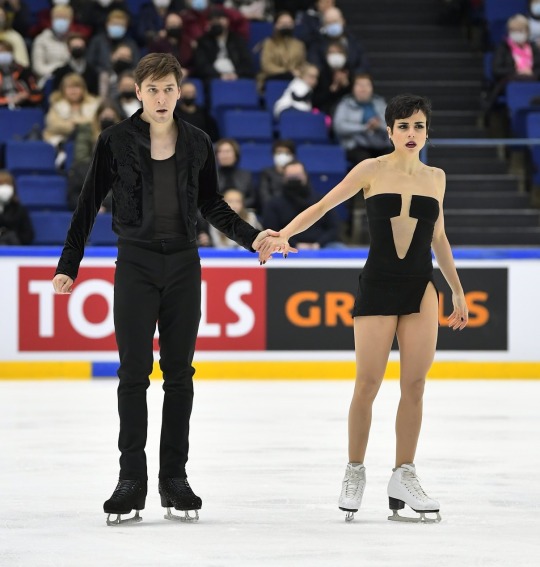

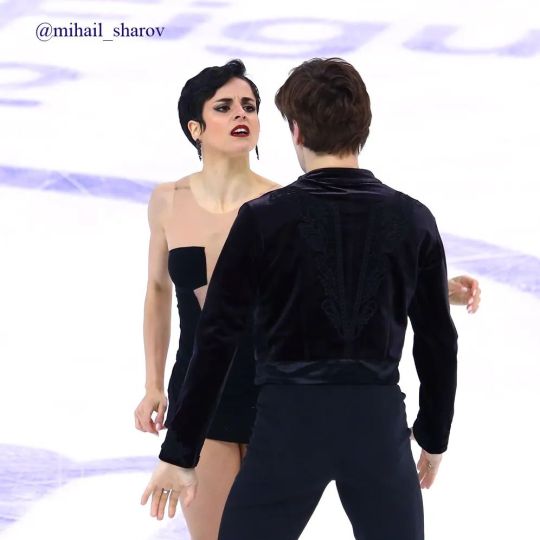

Sara Hurtado and Kirill Khaliavin's free dance costumes at the 2021 Finlandia Trophy and 2021 Rostelecom Cup. They skated to Since I've Been Loving You and Stairway to Heaven by Led Zeppelin.
(Sources: 1, 2, 3 and 4)
#Sara Hurtado#Kirill Khaliavin#Hurtado Khaliavin#Ice dance#Figure skating#Spain#2021–2022#2021 Finlandia Trophy#2021 Rostelecom Cup#Led Zeppelin
23 notes
·
View notes
Text
Wi-Fi situation update: the issue in the building supposedly got fixed, but our main Wi-Fi network still doesn't work, so we may or may not be being lied to either about what the issue was, or about it being fixed.
Either way, currently using shared Wi-Fi from dad's old phone (not the one mentioned previously, that was from his current phone), because I guess it works independently of whatever our main network relies on.
#misha's life shenanigans#i'm not a tech person and neither is mom we have no clue wtf is going on#in my mind i'm just yelling 'ROSTELECOM! WHERE IS THE WI-FI?!' the same way prigo was yelling at shoigu about ammunition
0 notes
Text
Yuzu's ice stories are so magnificent, he is the best 💙💙💙💙💙💙









Yuzuru Hanyu — Otoñal SP at Rostelecom Cup 2018
74 notes
·
View notes
Text
Why Yuuri is surprised to see Viktor cry
Yuuri’s famous three words at the end of episode 11 have been a source of anxiety and distress for fans ever since Yuri!!! On Ice first aired.
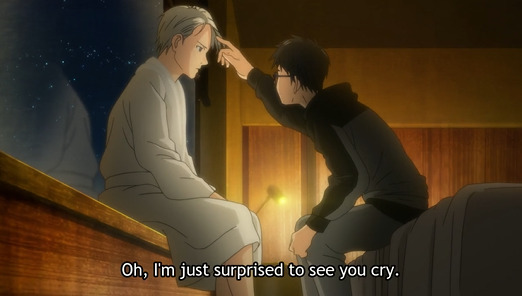
Yuuri’s surprise about Viktor crying is the result of thoughts and decisions prompted by his anxiety disorder and his tendency to self-deprecation and depressive thoughts. That he ends up saying this line has been carefully foreshadowed throughout the series:
1. Viktor making Yuuri believe that he only wanted to coach him until the GPF
Viktor never explicitly states that he will coach Yuuri only until the Grand Prix Final—it’s the conclusion Yuuri’s anxiety brain draws from his words because anxious people question everything and find interpretations that comply with the source of their anxiety. Like never being enough.
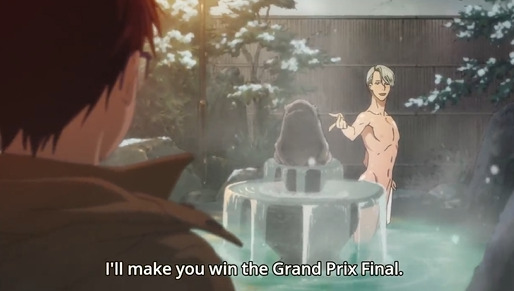
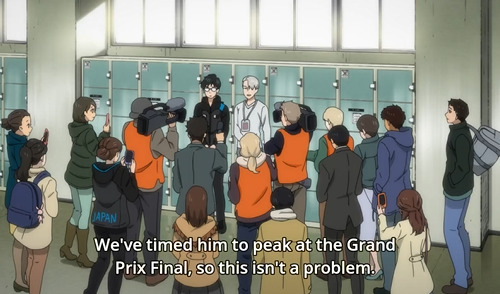
And the unintentionally ambiguous comments continue, while Yuuri is within hearing distance:
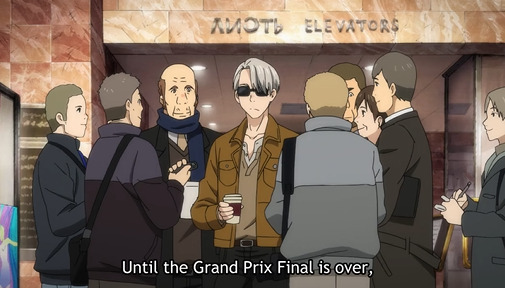
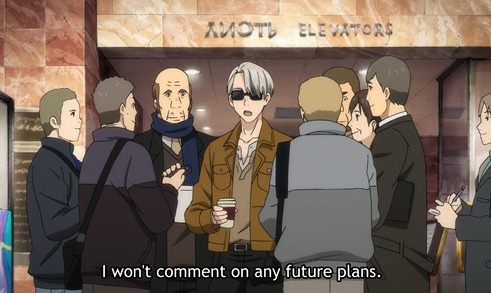
The first time I watched the anime, I got a queasy feeling in my stomach during this scene because Yuuri is so convincing and relatable as an unreliable narrator. It’s the source of fear and confusion. Like what does that even mean? Is Viktor talking about his career or is this a carefully crafted answer to convince the press to leave him and Yuuri alone for the next couple of weeks? This secret will probably be forever between Viktor and the YOI creators alone. Viktor is that adept at talking to the press.
2. Lack of self-esteem
Although Yuuri becomes more confident throughout the series, his self-deprecating side has a low opinion about his own skating. From his perspective, his contribution to the sport seems less valuable than Viktor’s, even when he begins to understand that he’s far more than a dime-a-dozen skater. The realisation that he is as least as talented as Viktor, only drives home the moment he breaks Viktor’s world record.
Because Yuuri has such a low opinion of himself, he doesn’t understand how much Viktor enjoys watching him skate, which is another aspect factoring into his decision to retire.
3. Guilt
Yuuri genuinely believes that Viktor wants to return to the ice and would rejoice when Yuuri retires. Having just witnessed Viktor watch his competitors skate (and do better than him) cements the decision he made at the Rostelecom Cup. The fact that basically everyone has told Yuuri throughout the series so far that he’s keeping Viktor from skating gives more weight to the idea.
Yes, you got that right. Yuuri decided to retire, before he proposed to Viktor and before he bought two matching rings and put one of them on Viktor’s finger. However, Viktor’s readiness to keep coaching Yuuri for as long as Yuuri wants to keep skating, forces him to release Viktor from his duties and he chooses the date at which Viktor has allegedly planned to end their work relationship.
“Let’s end this” is not about breaking up. Yuuri is releasing Viktor as his coach. He is sacrificing his career so that Viktor can keep pursuing his own career which Viktor once sacrificed for him.
Of course, he’s surprised that Viktor bursts out in tears.
Yuuri has the right to retire whenever he wants. He doesn’t need to consult Viktor. If he thinks (for whichever stupid reason) it’s time, he can make this decision without consulting his coach and partner. Although it would have been better, but then verbal communication isn’t one of Yuuri’s strength.
The decision to retire is the antipode of selfishness because it stems from Yuuri’s agape, even though his mental issues distort his thinking. However, Viktor takes personal offence in Yuuri’s choice, calling him selfish, because he’s conflating the coach and the partner. His inability to understand that Yuuri did that for him inflicts feelings of hurt and rejection, causing a drama Yuuri was not prepared for.
However, neither Yuuri nor Viktor are to blame since the whole situation is created and exacerbated by their individual underlying mental issues. Viktor still only scratches on the surface of understanding how Yuuri’s anxiety and lack of self-esteem inform his actions and distort his thinking. And Yuuri doesn’t know how miserable Viktor was when he was still competing.
If both had better communication skills, they would have sooner found a solution with which both would be happy (both training in St. Petersburg *wink* *wink*). However, it’s neither malice, nor insensitivity, or shitty behaviour that drives Yuuri to this point, but his mental issues. And love.
610 notes
·
View notes
Text
Today’s translation #936
Yuri!!! on Life, official guidebook, Season Calendar
[Notes: I was surprised to see in the past that a part of the fandom thinks that there was a year gap in the show. I think it was because of a wrong translation of 翌年 = the next year, as in March of next year vs. December of the previous year, but still, there is official timeline in the guidebook, and it is as follows ↓]
~The previous season~
December
>> Grand Prix Final (Sochi)
>> Japanese National Championships
(December~January national eliminations for World Championships)
January
>> European Championships
February
>> Four Continents Championships
March
>> Junior World Championships
>> World Championships
April
>> Onsen on ICE
Spring~Summer
>> Time for choreography, camps etc.
~The current season~ (starts in July)
October
>> Chugoku-Shikoku-Kyushu Regional Championships
(Regional championships for every area)
>> GP series Skate America
>> GP series Skate Canada
November
>> GP series Cup of China
>> GP series NHK Trophee
>> GP series Trophee de France
>> GP series Rostelecom Cup
December
>> Golden Spin
>> Grand Prix Final
36 notes
·
View notes
Text
Yuri Whump | Yuri!!! on ICE

1x01 Easy as Pirozhki!! - Anxiety lore, meltdown, depression weight, 1x02 Two Yuris?! - Kicked, stepped on, jealous 1x03 I Am Eros, and Eros is me?! - Anxiety, 'passes' out (20:30) 1x04 Like Yourself… - Failed spin 1x05 Face Beet-Red!! - Nervous, paranoid, face slams into the fucking wall during a spin, nose bleed
1x07 Cup of China Free Skate - Visibly/physically tired, failed jump, very nervous, crying (failed motivation)
1x09 Rostelecom Cup, Free Skate - Overthinking, nervous, hug-zombie
1x10 Pre-Grand Prix Final Special - Insomnia, nervous (lost bag), drunk pictures (21:20) 1x11 Pre-Grand Prix Short Program - Collapses (06:00) 1x12 Pre-Grand Prix Free Skate - Crying
#whump#emotional whump#whump list#whumplist#anime whump#yuri on ice#yuri on ice whump#yuri whump#yuri
78 notes
·
View notes
Text
Episode 9 of Yuri on Ice, Viktor is leaving for Japan (to go be with Makkachin) and he tells Yuuri, "If you're in trouble, just hug him (Yakov), and he'll help you."
I LOVE WHAT THIS IMPLIES ABOUT VIKTOR AND YAKOV'S RELATIONSHIP. (We know Viktor expresses much of his affection through touch. Hearing this quote made me 🥹😭 fr)
Also, the way Yakov rejects Viktor when he asks to hang out in an earlier episode (because he wants Viktor to stop 'playing at being a coach'), but in episode 8 when Viktor asks Yakov to look after Yuuri for the Rostelecom free skate, Yakov says yes. Yakov is a loyal support figure for Viktor and I would die to see more of how he's supported Viktor throughout his life
79 notes
·
View notes
Text
임은수 Eunsoo Lim (KOR)
2018 Rostelecom Cup 2018 Free Skate (127.91)
2 notes
·
View notes
Text

Thank you so so much for the ask @fern-foxx, I would love nothing more than to info dump <3.
PREPARE FOR 6130 WORDS THAT WILL MAKE YOU REGRET EVER ASKING ME TO DO THIS!
First things first, I have spent the last 4 hours formatting a response to your ask, only for tumblr to turn around and shit itself, and not let me post it. So I am restarting and trying it in the form of a proper post.
I think I had too many photos and links. So have put all my links in a linktree for your and tumblr's convenience (otherwise this post couldn't happen). Will just do a number coding system.
I have only gotten into figure skating recently. It started when some friends got me to watch Yuri on Ice and it's all been downhill since then.
The competition series I've been watching is the Grand Prix. This is on from October to December and is an elite level competition.
There are 2 programs that each skater competes, and I will go more in-depth later. But basically, there is the short program which is first - this is 2:40 +/- 10sec and the free program which is 4:00 +/- 10sec.
There are 6 qualifying events across the world, and skaters will be assigned either 1 or 2 competitions depending on how well they did at World's in March as well as some other criteria.
The competitions and when/where they were held this year:
Skate America - Oct 18-20 (Allen, TX)
Skate Canada - Oct 25-27 (Halifax, NS)
Grand Prix de France - Nov 1-3 (Angers)
NHK Trophy - Nov 8 -10 (Tokyo)
Finlandia Trophy - Nov 15-17 (Helsinki)
Cup of China - Nov 22-24 (Chonqing)
These are held in the same country every year (in 2022 Finlandia replaced the Rostelecom Cup in Russia for obvious reasons). The Junior Grand Prix has 7 qualifying competitions held between August and October and the locations of these change every year.
And then there’s the final:
Grand Prix Final - Dec 5th-8th (Grenoble, France)
The final is held in a different location each year and hosts both the seniors and juniors.
There are 12 skaters in each competition, and they'll get points based of how they place. At the end of the 6 competitions, the top 6 with the most points will go to the final.
The points:
1st - 15pts 2nd - 13pts 3rd - 11pts and so on... until 7th which is 4pts and 8th - 3pts.
There are various tie brakers in place, the first 2 are highest placement and if that ties -> highest total score (the list really keeps on going there are so many in the event all the tie brakers are tied).
Okay, now you understand how the Grand Prix works, we can go a little more in depth.
The Assignments
I said that these are based off of their placements in World's of the last season. The top 12 are guaranteed 2 assignments, the top 6 of these are called "seeded skaters." These are carefully assigned so that #1, #2, and #3 don't face each other at an assignment, and #4, #5, and #6 don't face each other. You can imagine that it would be unfair to have all the top skaters at 1 competition.
I made this helpful table to show who the top 6 at World's were in the men’s category:

The first number was their total score, second their short program, 3rd their free program, and then it has their 2 assignments. Shoma Uno placed 4th but retired that season so it bumped everyone up and the free spot went to Deniss Vasilijev. I won't share my women's table cause it is a total mess with several dropping out last minute.
The top 24 on the ISU (International Skating Union) world standings and season's best list also get 1 spot. Once all of those spots are filled, there is this sketchy ‘Host Pick’ rule. The host country of a competition gets to pick 3 of its own skaters to be at its competition. This could be giving someone with 1 slot an extra assignment or giving it to a local skater to draw in crowds. But the thing is, host picks don't have to meet the minimum score requirement?!?!? More on that later...
Other things that will put you in the pool for assignment consideration - are if you medal at the junior grand prix and are moving into the senior division. Or if you are a previous seeded skater who didn't participate in the last season due to heath/injury. After that, they look at the top 75 season's best list who meet that minimum score requirement.
The minimum score requirement is different for every division and changes every year. It is calculated by taking ⅗ of top score at the previous World's. In my table you can see that Ilia Malinin won with a total score of 333.76, so the minimum score for men in the 2024 Grand Prix is 200.26. (This year it was 133.77 for women). This minimum score also must have been achieved at an official ISU event (world championships, grand prix series, challenger series).
It is also worth noting that there is a limit of 3 skaters representing the same country at an assignment. Though there can be more than 3 if they make it to the final. See this year's final being 5 Japanese Women + Amber Glenn from the USA.
Now I want to tell you about the program requirements (for single, senior skating).
The Short Program
duration: 2:40 +/- 10 seconds
jump elements: 3
spin sequences: 3
1 step sequence
Both men and women must perform a double or triple axel, and a jump combination with 2 jumps. In addition to this, men must perform any triple or quadruple solo jump, and women any triple. The solo jump has to be different from the ones in combination. Because of their body shape, men can generally make more rotations in jumps than women, barely any senior women do quads after their body changes.
Both men and women must do 1 spin with a flying entry (any position), 1 combination spin with at least 2 different types of spins (camel, sit or layback). For the 3rd spin - spin in one position, men do either a camel or sit spin with 1 change of foot, and women can do any position but no change of foot. The position has to be different from their flying spin. As for rotations, for it to count you need a minimum of 8 rotations if you are not changing your spinning foot, and 6 if you are doing a change of foot.
The step sequence is a showcase of difficult steps and turns across a large surface of the ice, usually lasts at least 30 seconds.
Spins and step sequences get a level between 1 and 4 based off how complex and well executed they are. With 4 being the best and the standard for high level competitors.
The Free Skate
duration: 4:00 +/- 10 seconds
jump elements: 7
spin sequences: 3
1 step sequence
1 choreograph sequence
Both men and women must do 1 axel at any point. There is a maximum of 3 jump combinations allowed, with 4 other solo jumps. Most of them will do a jump sequence, which is when the second or third jump in a combination is an axel. Only 1 combination is allowed to have 3 jumps, the rest can only have 2.
Only 2 triples or quads can be repeated twice, of that, you can only repeat 1 quad (but can repeat 2 triples). This is to stop people from just doing their most high scoring jump over and over, this rule is colloquially known as the Zayaking rule. Elaine Zayak did 4 triple toe loops at World's in 1982 and it was changed after then.
As for spins, for both men and women it's 1 spin combo, 1 spin with flying entry, 1 spin with only one position. Change of foot and flying entry are optional extras for all spins, there are no restrictions like with the short program. 6 rotations must be achieved in the fly spin and spin in one position, and 10 rotations in the combination.
Step sequence same as above.
The choreograph sequence needs at least 2 artistic skating movements such as the spiral, spread eagle, or my personal favourite - The INA BAUER.
The Ina Bauer

Amber Glenn (USA) Cup of China free skate 2024, my gif
You can see the blades are parallel, the leading foot faces where you're going, and the knee is bent. The other leg is straight out behind you, slightly staggered. Most of your weight is on the front foot, and it requires really good turnout in your hips. It is named after Ina Bauer (b.1941 d.2014) a German skater who invented it. Did you know that this Friday the 13th is the 10 year anniversary of her death? Catch me at the rink doing as many Ina Bauers possible. Anyways, there are 3 different types of Ina Bauer, the easiest being inside Ina Bauer meaning you are on the inside edge of your blade and go in a circle like this:

^ This is my very beginner level Ina Bauer, I don't quite have the strength/balance/flexibility to move up the Ina Bauer food chain yet, but I have only been skating for a few months and will master it one day.
There's also an Ina Bauer on a straight line. Then there’s the hardest which is on the outside edge, this is a very good example:

Cha Jun-hwan (KOR) 2023 ISU World Team Trophy free skate (1)
See his Ina Bauer goes along the outside of an invisible circle, and mine faces inside? And a straight Ina Bauer is just a straight Ina Bauer, like the one Amber Glenn is doing in that first gif. You don't have to do it in a layback position, you can just have a straight back for it to count. It's not about back flexibility but rather hip flexibility. RAAAAGH INA BAUERS, I live for them.
One of my favourite moments from this year's Grand Prix is when Kevin Aymoz of France does an Ina Bauer into a triple axel in his free program!!!! How cool is that?!?!

Kevin Aymoz (FRA) Grand Prix Final 2024 free skate, my gif
Skaters get more points on jumps if they include a difficult entry/exit, so this boosted his grade of execution (more on that later!) It's also a good example of an Ina Bauer with the straight back. Kevin Aymoz is one of my favourite skaters, he's a bit of a gay icon.
Now I will tell you about...
JUMPS
There are 6 types of jumps you'll see in professional skating. Most of them will be triples, except for the women's axels where doubles are more common. Men will do some quad jumps but very few will do the harder ones like the flip, lutz, and axel. Then there's Ilia Malinin of the USA who can do all the quads and make it look effortless. There’s also the occasional double as the second/third jump in combination or as a solo jump if something has gone really wrong. (Solo doubles aren't even allowed in a senior short program)
All jumps look the same in the air, and land on the same foot backwards with an outside edge. What makes them different is the way you take off. There are toe jumps that use the toe picks, and edge jumps which use your edges.

Diagram (2)
You can see that the figure skating blade is not flat but rather curved in a sort of arch shape. If you are leaning inwards, you'll be on your inside edge and outwards on your outside edge. The toe pick be spiky so you can stab it into the ice to launch you far and into the air. Consequently, if you lean too far forward on your skates you can trip over your toe pick and fling forward (I have done this many a time). You are also supposed to land on the bottom part of your toe pick and then place your foot down. But if you land too far forward on your toe pick you also fly forward (I couldn't walk after I fell like this on Saturday lmao).
Most skaters will jump and spin anticlockwise, so the following information applies to them. But for the few that go clockwise, reverse the lefts and rights.
The 6 jumps, separated by type are -
Toe jumps:
Toe Loop (T): Right outside take off. Entered from turn. Left leg extends back, toe pick strikes ice.
Flip (F): Left inside take off. Entered from turn. Right leg extends back, toe pick strikes ice.
Lutz (Lz): Left outside take off. Entered from a long straight 1 foot glide. Right leg extends back, toe pick strikes ice.
Edge jumps:
Salchow (S): Left inside take off. Entered from turn. Legs sweep to form / \ shape.
Loop (Lo): Right outside take off. Left leg crosses over right, X shape.
Axel (A): Left outside take off. Only jump that takes off forward. Entered from back outside edge, left leg steps forward, right legs swings through to launch you.
For counterclockwise jumpers, all jumps land on a back right outside edge. Which means for jump combinations (where your landing edge has to be your take off edge) there are only 2 jumps that can be used as the second/third in combination. These being the toe loop and loop because they take off from that right outside edge.
This is unless a Euler jump is performed. This is a single jump used in combination to connect 2 jumps as it will take you from the right outside edge to the left. Interestingly, from the 2026-27 season onwards, Eulers will no longer be allowed in the short program, only the free. They will also no longer count as a listed jump nor add any base value to jumps (currently worth 0.5).
I've mentioned jump sequences in the free program requirements, but to expand on them. They are when your take off edge is different from your landing edge. I.e a small step is done so long as it doesn't disrupt the flow. Though since the 2018-19 season, only axel jumps are allowed as the second/third in a sequence. Also prior to 2022-23 sequences would only get 80% of the total base value for the jumps, but now it's full value.
It was also only in the 2018-19 season when the number of jump elements in a men's free skate went down from 8 to 7 (women's was already 7), and from 2026-27 onwards both disciplines will be going down to 6. That same season in 2018-19 the men's free skate went down from 4½ minutes to 4.
I should have mentioned this before, but figure skating seasons are from the 1st of July to the 30th of June so they span 2 years (not really, but that’s why I am using '2018-19' etc). The season starts with the Junior Grand Prix qualifiers in August - October, then the senior Grand Prix qualifiers in October - November with the final in December. December to January is when most countries hold their nationals. January is also the European championship. February has the 4 Continents (which is everyone BUT Europe), and March is the World Championships. When the Olympics are on in Februarys the 4 Continents are moved to January.
There's also The Challenger Series which is a step below Grand Prix. These competitions are required to take place between August 1st and December 15th. There are several competitions worldwide, but they don’t have a final. Sometimes Grand Prix skaters will compete in them to boost their rankings as they count towards the season's best list and can be where you get your ISU minimum score requirement that we talked about earlier.
Redirecting this back to jumps, here is a table of base values. You can see them ordered from lowest to highest to give you a sense of what’s easier vs harder.

Speaking of base values, I think it's about time I introduced you to...
The ISU Judging System
Now this can be EXTREMELY confusing at first, but in time it will make sense, and I hope I explain it well enough.
Both the short and free scores are broken into 2 sections. You have your Technical Score (TES) and your Program Component Score (PCS).
Technical Score - every element you perform has a base value (BV) that is added to your score. This is the easy part. Now where it gets complicated is with the Grade of Execution (GOE). Each judge (there's usually 7 - 9 in big comps) assigns a number between -5 and 5 based off how well it is executed.
Now bear with me here...
The highest and lowest GOEs from the judges are discarded, and the rest are averaged. The GOE average is then multiplied by 10% of the BV. This is your final GOE for a skill, this number is then added to the original BV to give a final FINAL score for a skill.
EXAMPLE:

The quad lutz had a base value of 11.5.
The 1 and 3 are discarded. (Highest and lowest)
(2+2+3+2+2+2+2) /7 = 2.14 - the average GOE
11.5 x 0.1 = 1.15 - 10% of the BV
2.14 x 1.15 = 2.46 - total GOE
11.5 + 2.46 = 13.96 - final skill score
Personally, I love how much maths is involved!! It's fun to just calculate these things even if the score sheets give you the final skill score anyways. It is really exciting once you understand how all of this works!! (yes, I am autistic if you haven't guessed already)
I would also like to note, that the current +/- 5 GOE system used to be +/- 3 but was changed in the 2018-19 season to make improper technique and falls have a bigger impact on scores.
Now the program component score (PCS). There are 3 categories: Composition, Presentation, and Skating Skills. A brief definition of all of them: Composition is the connection of your skills, use of the ice, and understanding of how the music relates to your program.
The standout example of this that I have to show you is from Kaori Sakamoto's free skate, I just LOVE how her jump take offs are on beat to the music!
Kaori Sakamoto (JPN) Grand Prix Final 2024 free skate
She actually got the highest PCS score out of the women in the Grand Prix Final!! It's easy to see why.
Presentation is engagement and expression with your music, and I guess general prettiness? Skating Skills is "a good range of steps, turns, and movements with blade and body control" tbh, I don't have a good understanding of what these look like, I guess it’s just vibe based. This is like an artistry score. It is just as important to have graceful skating that tells a story, as it is to have good technical abilities. The judging system and jump base values are always changing to try and balance this, and there a few systems in place to make this possible too.
Before 2022-23 there were actually 5 PCS categories, the 2 they got rid of were transitions – “intricate footwork, positions and movements that link all elements”, and interpretation (of the music) which I don’t fully understand, how many categories do you need in order to judge if a skater understands the music lol. This also meant that the factors increased in 2022-23 as they axed 2 categories.
So, for each of the 3 PCS categories, the judges assign a number between 0.25 and 10, and it goes up in increments of 0.25. Just like with the GOE, the highest and lowest numbers are discarded, and the rest are averaged. These averages are then added together and multiplied by a factor.
This factor is different for every discipline, because it is supposed to be as equal to the TES as possible. The women's factor is lower than the men's because they generally have a lower TES. And the short program is lower than the free skate because there are less technical elements.
The factors are as follows:
Mens Short Program: 1.67
Mens Free Program: 3.33
Women's Short Program: 1.33
Women's Free Program: 2.67
(the factors for pairs are the same as women's)
Let's look at Kaori Sakamoto's GPF free skate as an example, specifically her composition score:

The 8 and 9.5 are discarded, and the average is rounded to 2 decimal places equaling 8.93. This process repeats for the other 2 categories. These numbers are then added together (8.93 + 8.82 + 8.86 = 26.61) and multiplied by the factor. In this case, the women's FP is 2.67, so 26.61 x 2.67 = 71.05.
The maximum PCS possible:
Men’s short program: 50.00
Men’s free skate: 100.00
Women’s short program: 40.00
Women’s free skate: 80.00
Hopefully now you have a better understanding of how the judging system works! There is a little more to it, I will go into more into detail now. If you look at the detailed results from a competition you may see various symbols/letters next to skills. I will tell you what they mean and what they do to a score:
q - Jumps landed a quarter rotation short, doesn't affect base value, but will give you a negative GOE. The 'q' was introduced during the 2020-21 season.
< - Jumps landed between ¼-½ rotations short. Results in only getting 80% of the BV.
<< - Jumps landed more than ½ short a rotation. The jump will get downgraded. A 3Lz with a << will only get the BV of a 2LZ.
e - Edge call on a flip or Lutz. Remember how the flip takes off from an inside edge and the lutz an outside edge? Well, if you do it from the wrong edge, you will get an edge call and only 80% of the BV.
! - Edge warning. This means there was an unclear edge take off on a flip or lutz. There is no reduced BV, but the GOE will be less than 0.
V - For a spin that does not meet requirements, like a lack of rotations or variation in position. 75% of BV.
F - A fall. -5 GOE. There is also a -1 deduction for your first and second fall, a -2 for third and fourth, and -3 for 5th fall onwards.
+REP - Used if you do more than the allowed 3 combinations or 2 combinations + 1 sequence in the free program. The first jump will get 70% BV and everything after that doesn't count. It is also used for repeated single jumps; they'll also get 70% of BV.
+COMBO - You will see this in the middle of a combination. It happens when the skater steps out after landing a jump and still takes off for the next jump. Remember the point of a jump combo is to take off from the same edge you land on. This results in the following jump having no value.
* - Invalid element, skater receives 0 points. This is for any element that breaks a rule. Like a single or double solo jump in the SP, an extra jump element done (only 3 in SP and 7 in FS allowed), repeating a certain triple/quad jump in the FS more than twice, if there is no axel done, the last jumping pass will be invalid too. Also used alongside +REP to invalidate extra jumps in combinations. Before 2016-17, an invalid jump in a combination would invalidate the entire combination. And from 2026-27 onwards, the same type of jump can't be included in the FS regardless of rotations (currently more than 3 of the same jump can be included if you do 3 triples and a double for example).
x - This is the only good symbol! It is placed after the last jump element in the SP or the last 3 jump element in the FS (provided they are in the second half of the program). It adds an extra 10% to the BV of your jumps. As the program goes on skaters will get more tired so are rewarded for doing difficult stuff at the end. Consequently, this system was heavily abused until a rule change in the 2018-19 season. It used to be that all jumps in the second half would get the extra 10%. You can then imagine people would just stack their programs to have all the jumps in the second half. This was then changed to better balance program composition.
There are also other deductions besides falls. It's -1 for every second up to 5 that your program goes overtime. -1 for costume parts falling on the ice, -1 for costumes that don't meet requirements, -1 if you take more than 30 seconds to get into your starting position after your name is called, -2 for illegal moves (back flips were recently legalised, if you want to watch programs with back flips, I recommend Adam Siao Him Fa of France).
If you do want to watch figure skating, I will quickly explain what the thing in the top left corner is. It's relatively straight forward

The squares at the top represent the 12 elements that make up the free skate (short program will have 7 squares). The green means they successfully performed an element, the red means they performed it, but it got a negative GOE. Now you also know what it takes to get a negative GOE thanks to the information above ;)! If there is a dark grey, it means it’s under review still (?). This bar will fill up as they go through the program.
It will tell you the most recent element performed, as well as the BV for it, and their GOE. This is the GOE after that multiplying the average by 10% BV nonsense. Under this you'll see the skaters TES go up throughout the program, and underneath it is the leader's TES.
AND THAT CONCLUDES THE ISU JUDGING SYSTEM, THAT WAS A LOT BUT HOPEFULLY YOU GET IT NOW!
I will also share with you a helpful table I made in preparation for watching the Gran Prix Final. It has the finalists with their assignments, how they placed with qualifying points, and their total score earned in both assignments. As well as their personal bests and age. Interestingly, the men and women have the EXACT same average age of 21⅔. Which is super interesting cause usually the women tend to be younger than the men. Though this year the minimum age for the senior division was upped to 17. Last year it was 16 and before that it was 15 for quite a while. This was to protect minors more because of how intense it got with doping etc. I think it's a great change because I don't want to see tiny children when watching seniors, its also unfair cause the younger women can go hard out and learn quads before their body changes which is dangerous.

Adam Sia Him Fa qualified in 4th but had to drop out because of injury, Mikhail Shaidorov was 7th so he got moved up to replace Adam.
I really love looking up the skater's profiles on the ISU website, because some of them have the most insane listed hobbies. Check out Camden Pulkinen. Emo ass king.

Now I want to tell you about some of my favourite skaters!
Kevin Aymoz - France

Kevin Aymoz (FRA) Grand Prix Final 2024 gala exhibition, my gif
I have talked about him before. I love how dramatic his programs are, they have a lot of flair and camp energy. He was at Skate America and Finlandia Trophy and made it to the final! Unfortunately, he fell a few times and came last. He did get bronze at the 2019 GPF though! Did you know in 2021 he was in a French documentary called Faut qu'on Parle (we need to talk). It's about 6 elite athletes who come out for the first time and share their experiences of being queer. One of his listed hobbies is "catching pokémon" okay icon.
Amber Glenn - USA

Amber Glenn (USA) Grand Prix de France 2024 gala exhibition, gif credit below
LOOK AND HOW GORGEOUS AND HOT SHE IS. First off, SHE WON THE GPF CAUSE SHE'S SO AMAZING. Her assignments were Grand Prix de France, and Cup of China. Amber is a mental health advocate who is also queer and has ADHD, I love her so much. At the end of competitions, they will sometimes hold a gala exhibition. This is a showcase that some of the competition skaters partake in. It's a chance for them to do whatever program they want without the pressure of being judged - it's truly just for fun! Amber’s gala this year was to HOTOGO! Would definitely recommend checking it out. Here are some gif sets of it here on tumblr (3 4 5). Her hobbies are Magic the Gathering, anime, and cosplay. (It's funny cause when a skater lists anime as a hobby, you just knowwww they've seen Yuri on Ice. In this case, Amber worked with the creative team on the movie before it was cancelled). She was also the second American woman to land a triple axel at World's, the first ofc being Tonya Harding. Amber is a little bit of a legend, at age 25 she's kind of come out of nowhere and is starting to skate really well consistently. It was so cute when she found out she won the GPF. There's a camera where they can see the other skaters in the back, and the Japanese women did her FS finishing pose. It was such a sweet moment of amazing sportsmanship between these women. I will put a link to the clip posted on reddit here (6).
Matteo Rizzo – Italy

Matteo Rizzo (ITA) NHK Trophy 2024, my gif
Assigned - NHK, and Cup of China. He's just a silly guy. For starters, his SP music is a song called "Two Men in Love" an extremely gay love song. But then his FS music is.... "Fix You" by Coldplay? It's the contrast that I find so funny. His hobbies are Formula 1 and "airplanes" I too love planes. All of these things combined made him stand out to me as a bit of an icon. He also kind of looks like Christophe Giacometti from YOI, he's got the eyelashes for it. The gif is from the kiss and cry after his skate when he did this super funny gesture that absolutely sent me. What can I say, the man loves cars.
Jason Brown - USA

Jason Brown (USA) NHK Trophy 2024 short program, my gif
Skate Canada and NHK. Did you know that he came out as gay on Dan's birthday in 2021? My friends and I joked that Brown was fitting name cause he was dressed like a shit for his SP in that gif. I call him JJ if he slayed, cause his energy and mannerisms + the way he addresses the audience reminds me JJ from YOI but if he were gay. Also has a super camp gala exhibition, and won the junior GPF in 2011.
I love the galas that have a gimmick. Like Mikhail Shaidorov who did a Kung Fu Panda one in a giant panda suit. He somehow managed to land a triple toe loop in that costume too! Mikhail is a really good jumper. This season he made history by becoming the first skater to land a quad as the second jump in combination with his 3A + 4T!!!
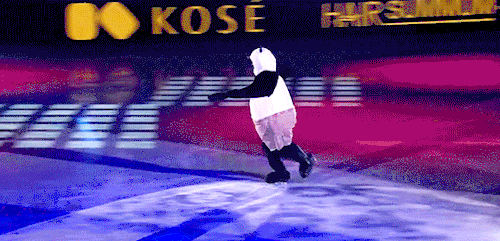
Mikhail Shaidorov (KAZ) Grand Prix Final 2024 exhibition gala (7)
He also has assistants come out in his gala and for the Grand Prix de France, Amber was one of them!
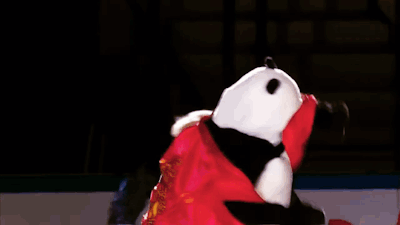
Amber and Mikhail Grand Prix de France 2024 exhibition gala (8)
Where you can watch the ISU stuff will depend on your country. I can watch it all for free on the ISU Skating youtube channel since I am in New Zealand and no other broadcaster covers it. The youtube videos are geo blocked in countries that have networks with a monopoly over the rights.
If you are also a fan of Yuri on Ice, I have some cosplay content recommendations too (if not, just skip this). I have fallen IN LOVE with these 2 particular cosplayers (Vehn and Svatti - yt channel: Weeb Chapel) who had a YOI skit series, here is the playlist on youtube (9). Svatti who plays Yuri also does a hilarious Chris which you can see in their Kiss Marry Kill in Character (10).

Cosplayer Svatti as Christophe Giacometti in "Yuri!!! on Ice KISS MARRY K-WORD!" youtube link in linktree, my gif
Svatti's Chris is also in the background as a voice in the Viktor and Yuri Google Questions Interview (11). Now I don't usually consume Otayuri content cause I find their age gap weird, but they have a gorgeous Otayuri CMV (cosplay music video) that I keep on watching (12). I have also started just watching all their other cosplay content. YOI is the only anime I've seen, but I really just love Svatti and Vehn (former username Mishkali) so much I'll watch anything with them. They are so attractive, and my gender envy is off the charts with everything they do, and Vehn’s Victor drives me fucking crazy in the best ways possible THE ACCENTTT. If you know of them or watch it and want to chat HIT ME UP!
My favourite CMV however is this one (13) by Rintamasuunta. The production BLOWS MY MIND DUDE. Even if you haven't seen YOI you should still watch it. The sets, costumes, choreography, ah too good. One of them is even an actual skater and you get to see them do parts of the routines in costume! I keep rewatching it time and time again.
One last Yuri on Ice thing - Joel Minas on youtube has recreated some of the programs in full. It is just so impressive to see them bought to life. Here is his playlist (14)
And there we have it folks!! There's a lot more that I could have included, I have so many more thoughts. I'm sure y'all are familiar with the feeling of being in the trenches of a hyper-fixation. You ask for an info dump; you get an info landfill that took a couple days and many MANY hours to assemble (WORTH IT!). I may or may not have taken it a bit too literally when you asked to hear what I've learnt so far WELL HERE IS EVERYTHING. Are you regretting your life choices yet? If you or anyone else has any questions or wants to discuss figure skating, CONTACT ME PLEASE I LOVE TO YAP (evidently)!!! Also, if you have managed to read all of this you are insane, and I love you.
I still spend most of my days thinking about skating. I am at the rink 2-3 times a week and have started lessons. I hope to get really good at it someday. Researching competitive figure skating is so so so fun! I just love learning about the all the rules/the technical side. I have so many pages of notes. Finally, I will link some resources I found helpful if you want to do some further reading.
They’ll be in the linktree (sorry it had to be like this, tumblr just couldn’t take it) https://linktr.ee/pissterdaniel
Resources
15 Brilliant youtube video that breaks down the 6 jumps with examples to help you identify them
16 The soyouwanttowatchfs website has a lot of guides for people getting into figure skating
17 ISU Technical Panel Handbook 2024-25
18 ISU Technical Rule Book 2024 (160 pages of goodness)
19 Table of base values (a couple of seasons old as still has 5 PCS categories listed, but should (?) still be valid, it has +/- 5 GOE so is after 2018 but before 2022. I feel like one of those people who works out the date a globe is from, which honestly, I’d be into because I love geography (it’s the darn autism again isn’t it)).
20 Extremely detailed table of base values 2024
21 Short program outline
22 Free skate outline
23 The ISU website in general, good for detailed scores and skater profiles
Lmk if there are any issues with the links OR IF YOU HAVE ANY QUESTIONS OR COMMENTS, I'VE SAID IT BEFORE AND I’LL SAY IT AGAIN PLEASE CONTACT ME
Okay that is it, I just want to get this out there now, getting this from my word document to a successful tumblr post has taken 7 hours dear lord.
Hope this is a sufficient info dump @fern-foxx, it’s 6130 words. Thank you for your ask xxx
13 notes
·
View notes
Text
Impact of figure skating politics on post-canon Yuri!!! on Ice
So, even aside from the rampant doping, I think many people are familiar with how the politics within the sport of figure skating really suck -- whether that's in terms of how skating federations meddle with their athletes' careers in ways these athletes clearly don't want or don't even know about, the way regulatory bodies -- the International Skating Union (ISU), and its various Commissions -- can and do remain silent when it comes to speaking out on abuse or corruption, or the complete shit-show of bias within judging, sometimes on a ludicrously visible level.
After all, this is a sport where a judge that showed clear bias at the PyeongChang Olympics was not only invited back to judge at the Beijing Games, but was given the position of being the technical controller!
Sheer madness...
It makes sense why Yuri!!! on Ice didn't delve into this stuff in a 12 episode season b/c the reality is: it's a major bummer.
But I work in public policy and am a social justice researcher whose career focuses on institutional change. So I often find myself asking the question "what would cause institutions/people/movements -- especially with a lot of history and influence behind them -- to change for the better, whether by 'force' (public outcry, insider advocacy, etc.) or their own volition?" It's a question I started thinking about a lot almost as soon as I got into Yuri!!! on Ice a few years back, and specifically, thought about in a post-canon context.
Some of the politics-related questions that surfaced for me, included:
-When Viktor returns to skating, how would his federation (the FFKKR) choose to treat his absence? Would they, perhaps, "make an example" of him at the Rostelecom Cup, purposely underscoring his performances? Or, would they have "given up" on him, trying to focus all of their attention/resources on Yurio's obvious rising star potential?
-Further, would they (with tacit or explicit media support) take a negative stance regarding his and Yuuri's highly public relationship -- perceiving Viktor's romance as a "threat" to his ability to return to the field as strong and focused as before -- or would they choose to ignore it, altogether?
-How would Yurio's growth spurt (which is hinted at in canon) impact the FFKKR's treatment of Viktor if the former is no longer able to put out the kind of performance that he did at the Barcelona Grand Prix Final? Or if Georgi retires from the field?
-How would skaters that wish to skate independently of corrupt federations -- something that is currently not possible under the way the ISU is structured with 'member nations' -- navigate their careers, and what avenues would they have at their disposal to avoid burn-out from the shitstorm of pervasive corruption?
-How would politics affect our favorite characters at an event as globally visible as the PyeongChang Olympic Games, and in its aftermath? (I say this with the caveat that I generally write yoi fic w/ the premise that it took place during the first half of the 2016 skating season, though there is no way to pinpoint the actual season).
All of these questions kept circling about in my head, and I felt highly motivated to begin writing a multichapter, post-canon "future fic". Specifically, a fic that would tell the story of married Yuuri/Viktor at the 2022 Olympic Games, but jumping back in time at various points over the previous five years to showcase how a particular scandal -- other than doping -- at the 2018 PyeongChang Games has "followed them" throughout the years (and has deeply impacted the sport/our other favorite characters).
This fic turned into a series called "Gold's On The Inside, Elevated My Feet", which currently is at 293K total words, and is being updated 1-2 times per month.
I know a lot of people aren't into long, novel-length works, especially if they're WIPs, but if you, like me, are fascinated by some of the real-world issues that might impact Yuuri/Viktor/Yurio and others post-canon, I hope you'll consider checking my work out.
I've included a spoiler-free excerpt from Chapter 11 of part 1 of the series, below, that I feel hints at the politics while encapsulating the Viktuuri fluff, friendship antics, and overall supportive themes that I've tried to weave into my stories.
I hope it piques your interest and encourages you to check the series out, or my other Yuri!!! on Ice fics!
---------
“First of all, how the hell would you have even managed to contact me from all the way over in the Kiss and Cry?” Phichit went on. “Did they imagine you had waved a wand to send a carrier pigeon flying through Gangneung Ice Arena to land directly on my head ? After which, it would peck an intimidating message in Morse code straight onto my scalp?”
Yuuri was now hiccuping giggles, and he was pleased to see that he’d begun to wipe a profuse quantity of tears from his cheeks.
When his best friend had told him that he wanted to hear all the nitty-gritty details of his International Court of Arbitration for Sport (ICAS) hearing, Phichit had definitely had some misgivings; Yuuri and Viktor had flown to Lausanne for their own proceedings directly after the latter’s retirement party in Milan, and given what they’d told him about each brutally long-winded 4 hour session, he’d known fun things were not in store for him.
“But Yuuri without his glasses on can be very intimidating…very sexily intimdating,” Viktor said with a grin, prompting a playful slap on the arm from his fiance; thanks to Yuuri’s thirsty fans, the hashtag #Yuuri’sNearsightedSexySquintTally had become a staple on the competition circuit, and both he and Viktor had taken to alluding to the phrase as much as possible.
“Yes, I’m sure that’s exactly what permanent-frown-dude-arbitrator was referring to,” Yuuri responded, sarcastically, “my nefariously sexy squinting that so very clearly spelled out that Phichit better file a claim, or else.”
He and Viktor both laughed, and he shared a few more snippets from his hearing before conversation moved along to discussion around the other Olympics claimants’ hearings.
“Oh my god, just imagine Christophe during his,” Yuuri said, before giving Makkachin a kiss, right to the top of her fuzzy head.
The poodle was splayed out across both of her dog-dad’s laps, taking up much of the bench directly in front of the rink boards at Hasetsu’s Ice Castle. After their hearing, the couple had flown to St. Petersburg, spending just a few days there to get Makka and Meni and do a round of cursory packing. They’d then taken off for Japan where they planned to stay until mid-June, which was the beginning of the rainy season.
Even from afar, Phichit had been able to keep tabs on Yuuri thanks to Nishigori Yuuko. After thoroughly bonding with her at Viktor’s retirement party – after all, a willingness to drunkenly act out the unhinged plot of The King and the Skater 3: Because Time Loops Are A Thing tended to solidify people in Phichit’s mind as lifelong friends – she had been messaging him through Instagram as well as contributing heavily in the “Yuuri Support Squad” chat.
Soon enough, he’d be able to keep tabs on him in-person, as his own trip to Hasetsu was just three weeks away.
“He’d be all: ‘And then, my esteemed arbitrators, I got distracted from calculating Yuuri’s grade-of-execution, because my eyes were too busy lingering on his delectably muscled thighs as he came out of his triple-lutz, triple-toe combo’,” Viktor said, in a deliberately put-upon Swiss accent, while lasciviously licking his lips.
Phichit barked out a laugh while Yuuri grinned at him.
“Are you sure you aren’t just verbalizing the thoughts you wish you could have expressed during your hearing?” he asked his fiance.
Viktor gasped, theatrically, and clutched Meni even more closely to his chest before responding.
“I would never think such a thing! I’ve become an expert at admiring your beautiful thighs while simultaneously calculating your GOE,” he said, sounding proud. “As any good coach should be.”
#yuri on ice#yuri!!! on ice#viktuuri#victuuri#my writing#ao3 writer#victor nikiforov#viktor nikiforov#katsuki yuuri#yuuri katsuki#phichit chulanont
23 notes
·
View notes
Photo




Tiffany Zagorski and Jonathan Guerreiro's free dance costumes at the 2020 Rostelecom Cup and 2021 Russian Championships. They skated to Survivor (originally by Destiny's Child but covered by 2WEI).
(Sources: 1, 2 and 3)
#Tiffany Zagorski#Jonathan Guerreiro#Zagorski Guerreiro#Ice dance#Figure skating#Russia#2020–2021#2020 Rostelecom Cup#2021 Russian Nationals#Survivor#Destiny's Child#2WEI
12 notes
·
View notes
Text
Yuzuru Hanyu's K&C reactions to breaking World Records (Through the Years)
Historical world records (during the +/-3 GOE ISU scoring system)
1) October 19th, 2012 (Skate America) - Parisienne Walkways 95.07
2) November 23rd, 2012 (NHK Trophy) - Parisienne Walkways 95.32
3) December 5th, 2013 (GPF) - Parisienne Walkways 99.84
4) February 13th, 2014 (Sochi Olympics) - Parisienne Walkways 101.45 (Yuzu was the first men's single skater in history to score above 100 points)
5) November 27th, 2015 (NHK Trophy) - Ballade No. 1 106.33
6) November 28th, 2015 (NHK Trophy) - SEIMEI 216.07 (Yuzu became the first men's single skater in history to score above 200 points)
7) November 28th, 2015 (NHK Trophy) - Total 322.40 (Yuzu became the first men's single skater in history to score above 300 points)
8) December 10th, 2015 (GPF) - Ballade No. 1 110.95 (Yuzu was the first and remains the only skater to score above 110 points before the 2018-19 season*)
9) December 12th, 2015 (GPF) - SEIMEI 219.48
10) December 12th, 2015 (GPF) - Total 330.43 (Yuzu remains the only skater in history to score above 330 points prior to the 2018-19 season)
11) April 1st, 2017 (World Championships) - Hope & Legacy 223.20 (Yuzu became the first and remained the only skater in history to score above 220 points in the free skate prior to the 2018-19 season)
12) September 22nd, 2017 (Autumn Classic) - Ballade No. 1 112.72
Modern World Records (*during the +/-5 GOE ISU scoring system introduced in the 2018-19 season)
13) November 3rd, 2018 (GP Helsinki) - Otoñal 106.60
14) November 4th, 2018 (GP Helsinki) - Origin 190.43
15) November 4th, 2018 (GP Helsinki) - Total 297.12
16) November 16th, 2018 (Rostelecom Cup) - Otonal 110.53 (Yuzu became the first skater in the new system to score above 110 points)
17) March 23rd, 2019 (World Championships) - Origin 206.10 (Yuzu became the first skater to score above 200 points in the new system)
18) March 23rd, 2019 (World Championships) - Total 300.97 (Yuzu became the first skater to score above 300 points in the new system)
19) February 7th, 2020 (Four Continents) - Ballade No. 1 111.82
62 notes
·
View notes
Text
“The closer the collapse of the empire, the crazier its laws.”
— Marcus Tullius Cicero
The Russian government openly announced the blocking of YouTube in the fall. News and rumors about this circulated from the very beginning of the war, many social networks were blocked, YouTube was not touched, but they constantly threatened that it would be closed too. The government doesn’t like that YouTube is a huge window into Europe and the world, and that there are a lot of independent media and bloggers on YouTube who oppose the war and call for an immediate stop to all this. And now the television company Rostelecom (especially the "sanctions" paragraph) has announced a slowdown in the work of YouTube, and then a complete stop in Russia (https://rtvi.com/news/gazeta-ru-soobshhila-o-planah-zablokirovat-youtube-v-rossii-osenyu/). And as usual, they blame Google for everything, saying that it’s because of their poor equipment that nothing works. This is a complete lie. The authorities deliberately block everything they want, blaming everyone they can.
8 notes
·
View notes
Text


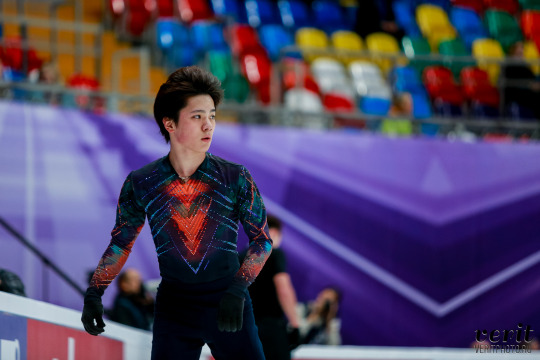

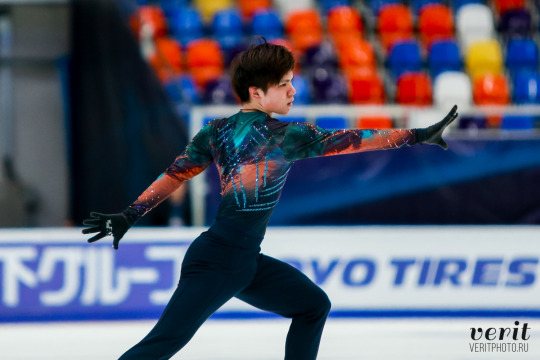
Shoma Uno — Great Spirits SP (Practice) at Rostelecom Cup 2019
#shoma uno#figure skating#fsphoto#men#cor 2019#team japan#i decided there's no harm in going thru photos from one competition
73 notes
·
View notes